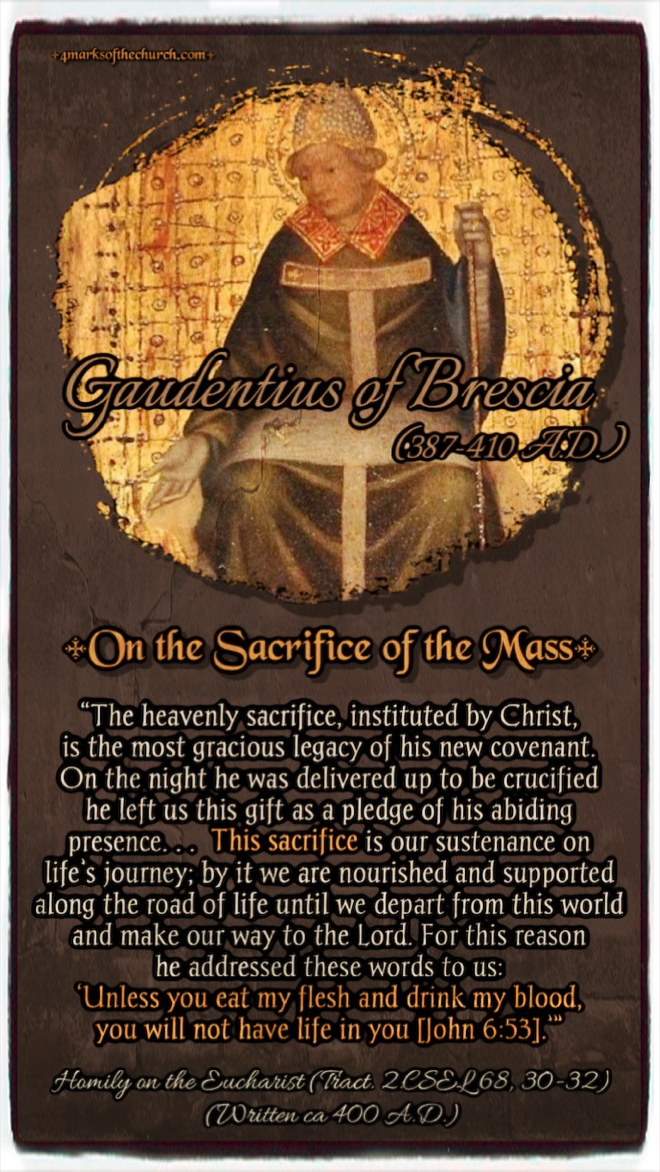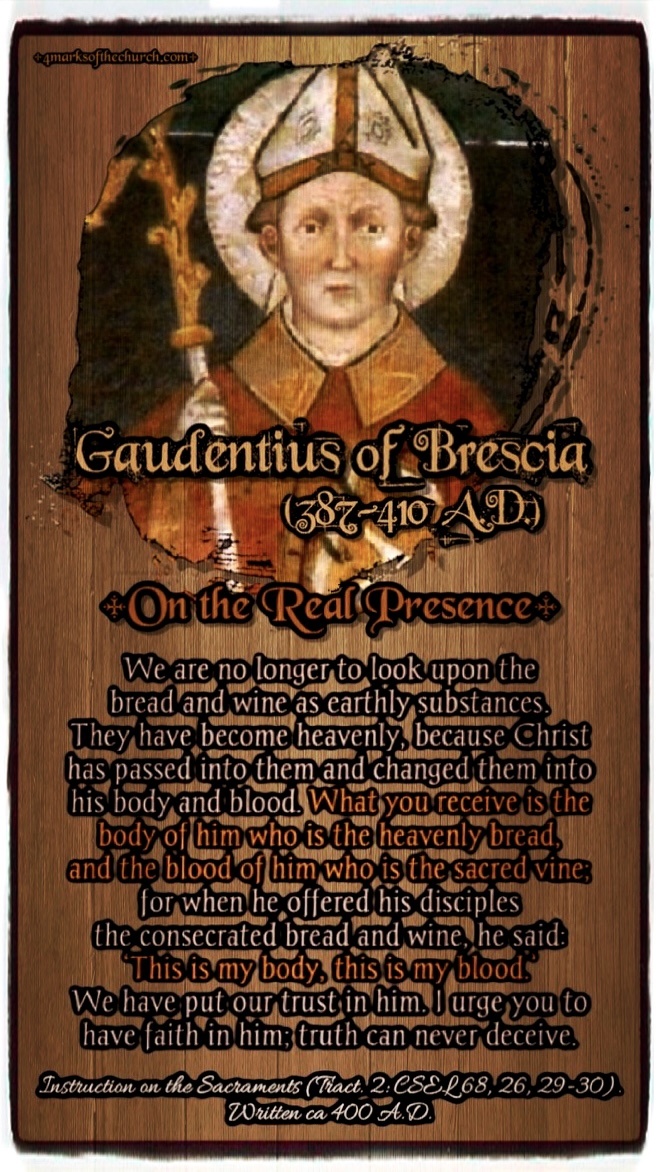St. Gaudentius of Brescia
Scroll for quotes→






Gaudentius of Brescia was Bishop of Brescia from 387 until 410. Gaudentius had studied under his predecessor, St. Philastrius, and was a preacher in Italy and the Middle East. After the death of Philastrius, Gaudentius was consecrated bishop by Saint Ambrose in 387. A record of the discourse given by Gaudentius on the occasion of his consecration still survives today. Gaudentius reported upon his consecration that he had brought back with him from the Holy Land relics of Saint John the Baptist, the Apostles, relics of saints from Milan, and of the Forty Martyrs of Sebaste, the last of which had been given to him by the niece of Saint Basil at Caesarea in Cappadocia. He deposited these relics in a basilica that he named Concilium Sanctorum, and wrote a sermon upon its dedication.
Gaudentius and the Archbishop of Constantinople, Saint John Chrysostom, were friends and according to one of John Chrysostom’s letters, the two may have met at Antioch. Gaudentius joined a delegation in 405 sent by Innocent I and Honorius to defend Chrysostom to the Eastern Emperor Arcadius after Chrysostom had been exiled by a heretical sect.
Gaudentius and his companions, two bishops, encountered many difficulties and never reached their goal of entering Constantinople. At the start of their journey Gaudentius and his two companions had been seized at Athens and were then imprisoned in the fortress of Athyra, in Thrace. They were then put on board an unseaworthy vessel and the ship’s captain was allegedly given orders to shipwreck them. They arrived safely, however, at Lampsacus and departed for Italy, arriving at Otranto after twenty days. Despite the failure of the mission, Chrysostom sent a letter of thanks to Gaudentius. Many of Gaudentius’ religious tracts and pastoral letters still survive today.
Writings:
- 21 religious tracts and 10 pastoral letters still survive
return to top ⇑
Quotes and Excerpts:
St. Gaudentius of Brescia’s post-baptismal instruction on the sacraments, aka mystagogia, (Tract. 2: CSEL 68, 26, 29-30)
“One man has died for all, and now in every church in the mystery of bread and wine he heals those for whom he is offered in sacrifice, giving life to those who believe and holiness to those who consecrate the offering. This is the flesh of the Lamb; this is his blood. The bread that came down from heaven declared: The bread that I will give is my flesh for the life of the world.
It is significant, too, that his blood should be given to us in the form of wine, for his own words in the gospel, I am the true vine [John 15:1], imply clearly enough that whenever wine is offered as a representation of Christ’s passion, it is offered as his blood.
This means that it was of Christ that the blessed patriarch Jacob prophesied when he said: He will wash his tunic in wine and his cloak in the blood of the grape. The tunic was our flesh, which Christ was to put on like a garment and which he was to wash in his own blood.
Creator and Lord of all things, whatever their nature, he brought forth bread from the earth and changed it into his own body. Not only had he the power to do this, but he had promised it; and, as he had changed water into wine, he also changed wine into his own blood.
It is the Lord’s Passover, Scripture tells us, that is, the Lord’s passing. We are no longer to look upon the bread and wine as earthly substances. They have become heavenly, because Christ has passed into them and changed them into his body and blood. What you receive is the body of him who is the heavenly bread, and the blood of him who is the sacred vine; for when he offered his disciples the consecrated bread and wine, he said: This is my body, this is my blood. We have put our trust in him. I urge you to have faith in him; truth can never deceive.
When Christ told the crowds that they must eat his flesh and drink his blood, they were horrified and began to murmur among themselves: This teaching is too hard; who can be expected to listen to it? As I have already told you, thoughts such as these must be banished. The Lord himself used heavenly fire to drive them away by going on to declare: It is the spirit that gives life; the flesh is of no avail. The words that I have spoken to you are spirit and life.”
Gaudentius of Brescia Latin sermon (Sermon 17) on the dedication of a basilica on the occasion of his consecration as Bishop of Brescia (ca 402 A.D.)
“For our God has granted that we might have the relics of saints for veneration. He has given that we might be able to lay the foundation of this basilica in their honour.’
‘We have at present relics of these blessed four. As proclaimers of the kingdom of God and his justice slain by unbelievers and wicked men they are shown by the power of their works to live always with God. John is reported to have been put to death in Sebaste, a town in the province of Palestine, Thomas among the Indians, Andrew and Luke at Patras, a town of Achaia’.”
Excerpt from a homily by St. Gaudentius, bishop of Brescia, on the eucharist to the newly baptized (Tract. 2:CSEL 68, 30-32).
“The heavenly sacrifice, instituted by Christ, is the most gracious legacy of his new covenant. On the night he was delivered up to be crucified he left us this gift as a pledge of his abiding presence…
This sacrifice is our sustenance on life’s journey; by it we are nourished and supported along the road of life until we depart from this world and make our way to the Lord. For this reason he addressed these words to us: Unless you eat my flesh and drink my blood, you will not have life in you [John 6:53].
It was the Lord’s will that his gifts should remain with us, and that we who have been redeemed by his precious blood should constantly be sanctified according to the pattern of his own passion….
And so he commanded those faithful disciples of his whom he made the first priests of his Church to enact these mysteries of eternal life continuously. All priests throughout the churches of the world must celebrate these mysteries until Christ comes again from heaven.
Therefore let us all, priests and people alike, be faithful to this everlasting memorial of our redemption. Daily it is before our eyes as a representation of the passion of Christ. We hold it in our hands, we receive it in our mouths, and we accept it in our hearts…
It is appropriate that we should receive the body of Christ in the form of bread, because, as there are many grains of wheat in the flour from which bread is made by mixing it with water and baking it with fire, so also we know that many members make up the one body of Christ which is brought to maturity by the fire of the Holy Spirit.
Christ was born of the Holy Spirit, and since it was fitting that he should fulfill all justice, he entered into the waters of baptism to sanctify them. When he left the Jordan he was filled with the Holy Spirit who had descended upon him in the form of a dove. As the evangelist tells us: Jesus, full of the Holy Spirit, returned from the Jordan…
Similarly, the wine of Christ’s blood, drawn from the many grapes of the vineyard that he had planted, is extracted in the wine-press of the cross. When men receive it with believing hearts, like capacious wine skins, it ferments within them by its own power.
And so, now that you have escaped from the power of Egypt and of Pharaoh, who is the devil, join with us, all of you, in receiving this sacrifice of the saving Passover with the eagerness of dedicated hearts. Then in our inmost being we shall be wholly sanctified by the very Lord Jesus Christ whom we believe to be present in his sacraments, and whose boundless power abides forever.“
return to top ⇑